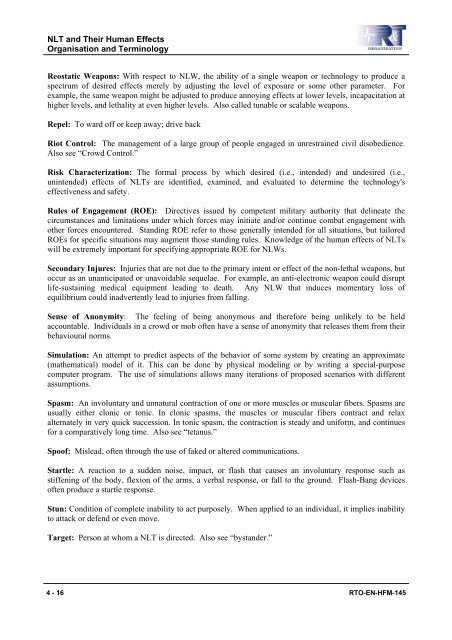NLT and their Human Effects - FTP Directory Listing - Nato
NLT and their Human Effects - FTP Directory Listing - Nato
NLT and their Human Effects - FTP Directory Listing - Nato
You also want an ePaper? Increase the reach of your titles
YUMPU automatically turns print PDFs into web optimized ePapers that Google loves.
<strong>NLT</strong> <strong>and</strong> Their <strong>Human</strong> <strong>Effects</strong><br />
Organisation <strong>and</strong> Terminology<br />
Reostatic Weapons: With respect to NLW, the ability of a single weapon or technology to produce a<br />
spectrum of desired effects merely by adjusting the level of exposure or some other parameter. For<br />
example, the same weapon might be adjusted to produce annoying effects at lower levels, incapacitation at<br />
higher levels, <strong>and</strong> lethality at even higher levels. Also called tunable or scalable weapons.<br />
Repel: To ward off or keep away; drive back<br />
Riot Control: The management of a large group of people engaged in unrestrained civil disobedience.<br />
Also see “Crowd Control.”<br />
Risk Characterization: The formal process by which desired (i.e., intended) <strong>and</strong> undesired (i.e.,<br />
unintended) effects of <strong>NLT</strong>s are identified, examined, <strong>and</strong> evaluated to determine the technology's<br />
effectiveness <strong>and</strong> safety.<br />
Rules of Engagement (ROE): Directives issued by competent military authority that delineate the<br />
circumstances <strong>and</strong> limitations under which forces may initiate <strong>and</strong>/or continue combat engagement with<br />
other forces encountered. St<strong>and</strong>ing ROE refer to those generally intended for all situations, but tailored<br />
ROEs for specific situations may augment those st<strong>and</strong>ing rules. Knowledge of the human effects of <strong>NLT</strong>s<br />
will be extremely important for specifying appropriate ROE for NLWs.<br />
Secondary Injures: Injuries that are not due to the primary intent or effect of the non-lethal weapons, but<br />
occur as an unanticipated or unavoidable sequelae. For example, an anti-electronic weapon could disrupt<br />
life-sustaining medical equipment leading to death. Any NLW that induces momentary loss of<br />
equilibrium could inadvertently lead to injuries from falling.<br />
Sense of Anonymity: The feeling of being anonymous <strong>and</strong> therefore being unlikely to be held<br />
accountable. Individuals in a crowd or mob often have a sense of anonymity that releases them from <strong>their</strong><br />
behavioural norms.<br />
Simulation: An attempt to predict aspects of the behavior of some system by creating an approximate<br />
(mathematical) model of it. This can be done by physical modeling or by writing a special-purpose<br />
computer program. The use of simulations allows many iterations of proposed scenarios with different<br />
assumptions.<br />
Spasm: An involuntary <strong>and</strong> unnatural contraction of one or more muscles or muscular fibers. Spasms are<br />
usually either clonic or tonic. In clonic spasms, the muscles or muscular fibers contract <strong>and</strong> relax<br />
alternately in very quick succession. In tonic spasm, the contraction is steady <strong>and</strong> uniform, <strong>and</strong> continues<br />
for a comparatively long time. Also see “tetanus.”<br />
Spoof: Mislead, often through the use of faked or altered communications.<br />
Startle: A reaction to a sudden noise, impact, or flash that causes an involuntary response such as<br />
stiffening of the body, flexion of the arms, a verbal response, or fall to the ground. Flash-Bang devices<br />
often produce a startle response.<br />
Stun: Condition of complete inability to act purposely. When applied to an individual, it implies inability<br />
to attack or defend or even move.<br />
Target: Person at whom a <strong>NLT</strong> is directed. Also see “byst<strong>and</strong>er.”<br />
4 - 16 RTO-EN-HFM-145
















